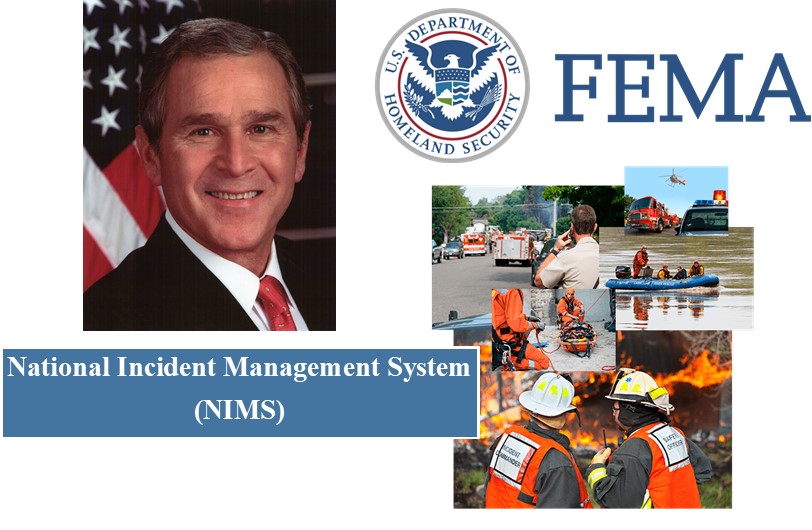In March 2004, the aUnited States Department of Homeland Security (DHS) formed a standardized framework for incident management called, National Incident Management System (NIMS). As a response to Homeland Security Presidential Directive-5 issued by President Bush, they have built NIMS to facilitate coordination between all responders, including all levels of government (federal, state, local, and tribal). NIMS works on 14 principles to help incident management run orderly, except restricting personnel from sharing information amongst themselves.
The key function of NIMS is to handle incidents and restore all service operations as fast as possible to have a lesser impact. The success of this is also because of effective communication amongst personnel.

Contents
The NIMS Management Characteristics of Chain of Command
NIMS Management characteristics works on 14 principles to help incident management run orderly. Each principle will contribute to the efficacy and efficiency of the system. Those are:
- Common terminology
- Modular organization
- Management by objectives
- Setting specific and measurable objectives
- Strategizing and knowing the task to attain goals
- Creating and issuing responsibilities, plans, procedures, and rules to complete the task
- Documenting results from the objective
- Incident action planning
- A manageable span of control
- Incident Facilities and Location
- Comprehensive Resource Management
- Integrated communications
- Establishment and transfer of command
- Unified command
- Chain of command and unity of command
- Chain of command- a linear setup from supervisor to subordinate
- Unity of command – each personnel report to one supervisor only
- Accountability
- Dispatch/deployment
- Information and intelligence management
Why is Restricting Personnel from Sharing Information Excluded in NIMS?
Restricting personnel from sharing information is not a part of NIMS Management’s characteristic of a chain of command. The reason is pretty simple and straightforward, and this is because sharing of information is crucial to every member of the NIMS management, especially to decision-makers. NIMS’ main goal is to handle incidents and restore all service operations as fast as possible to keep adverse impact at the minimum. Every bit of information may contribute to the progress and success of the incident objectives and goals. Personnel can see any dangers and risks and act upon them immediately. In addition to this, personnel can quickly identify the need for additional resources and ensure they get it when it is needed.
The importance of Sharing Information Amongst Personnel
The concept of sharing information is crucial in all types of incidents, whether it is minimal or extensive. For instance, personnel need to tell the current situation in an area before additional rescue can come in, or need to tell other agencies about the supplies they need. There are more benefits and demands for sharing information as part of the strategy than we know. Below are a few advantages of allowing personnel to share information among themselves:
- It promotes innovation and productivity. Permitting personnel to share information allows them to have more knowledge about the situation. It drives innovation that helps the team be more productive and keeps the team on top of new tactics.
- Collaboration and feedback. Understanding the benefits of sharing information makes personnel more open to collaborate and provide feedback between agencies.
- It promotes engagement. Sharing of information fosters the engagement of personnel to the NIMS activities, thus, increasing their commitment to the goal. It allows them to communicate across agencies openly. Above all, they would feel more valued.
- Creating more individual experts. Allowing personnel to access important information through information sharing will identify experts who can showcase their expertise to a specific incident.
- It reduces costs and time. When personnel are sharing information, it lessens future mistakes and time spent on an incident.

Risks in Restricting Personnel from Sharing Information
A well-conceived and effectively delivered information can help ensure the safety of the team, as well as the success of their plan. If personnel is sharing information with each other then, it will further facilitate response efforts, persuades collaboration, and aids in the unity of the team. Therefore, the risk of restricting them to share vital information may cause more problems in the future. The lack of communication among them will impede the effectiveness of the incident management plan. Moreover, confusion and conflict can happen while executing management plans and goals. It will also impact the efficacy of the process, let alone the risk of failing the purpose of NIMS.
The flow of information is allowed amongst personnel. However, the communication part of NIMS should also follow 4 key principles in order to protect the integrity of the process and its members, which are:
- Interoperability– it allows communication of organizations and agencies across a broad array of media such as email, video conference, and etc.
- Reliability, scalability, and portability – all information must be reliable and classified based on the incident’s need.
- Resilience and redundancy – all communication systems must provide uninterrupted service and be replicated if one system is down.
- Security – a secured communication system will prevent classified information from leaking out.
